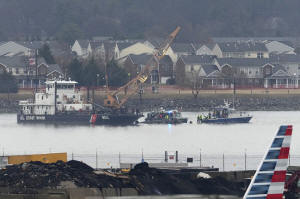Pilots have reported repeated close calls similar to fatal collision
near DC airport
 Send a link to a friend
Send a link to a friend
 [February 01, 2025]
By TARA COPP, MICHAEL R. SISAK and AARON KESSLER [February 01, 2025]
By TARA COPP, MICHAEL R. SISAK and AARON KESSLER
WASHINGTON (AP) — Airline pilots flying into Washington, D.C., have
reported nearly a dozen near misses that were scarily similar to this
week's midair collision that killed 67 people — the type of close calls
that led one aviator to complain that Reagan National Airport was
“probably the most dangerous” in the nation.
An Associated Press review of a federal database that catalogs such
concerns found scores of reports over the last two decades of
near-misses and warnings about congested skies over the nation's
capital, with pilots repeatedly complaining about military helicopters
getting too close to passenger jets.
Last May, one of those helicopters passed just 300 feet (91 meters)
below a commercial airliner, triggering a cockpit collision avoidance
alert and prompting the jet's pilot to file a report in the Aviation
Safety Reporting System, a database maintained by NASA that allows
pilots and crew to submit voluntary, anonymous and confidential safety
concerns.
“I never saw it,” the jetliner pilot wrote, adding that he “never
received a warning” about the helicopter from air traffic controllers.
Such complaints highlighted the tension that has developed between
commercial airline pilots unnerved by the helicopters and the military
units that have critical national security duties and must maintain
flying skills to execute them.
It is not clear if federal authorities were aware of such concerns or
took any steps to mitigate the risks. But on Friday, the Federal
Aviation Administration paused almost all helicopter flights from
operating near the airport, with exceptions for police and emergency
response. The president’s helicopter transport, Marine One, is also
exempt.
The pause came after an Army Black Hawk helicopter on a nighttime
training run collided with an American Airlines jet that was about to
land at the airport Wednesday night, plunging both into the dark, cold
Potomac River. No one survived.

Investigators are examining whether the helicopter was flying higher
than its allowed limit and whether control tower staffing was an issue.
A preliminary FAA report noted that one controller was performing duties
typically handled by two people at certain times of the day.
In the week before the crash, at least two planes had to abort landings
because helicopters got too close. In the days since, some officials
have questioned why the military flies so close to the airport.
“I have not yet heard a good reason why military helicopters are doing
training exercises in the same airspace as commercial airliners — at
night and with peak congestion. I hope these exercises in Reagan
airspace will be suspended indefinitely until the investigation is
complete,” Sen. Josh Hawley, R-Mo., tweeted.
More than a half dozen military, federal and local agencies operate
helicopters in the airspace near Ronald Reagan Washington National
Airport, and they need those same air routes to train for and execute
their missions, current and former Army pilots said.
The Black Hawk lost in the collision was part of Fort Belvoir’s
Virginia’s 12th Aviation Battalion, which “has had some classified, very
important missions related to our nation’s worst day,” said Brad Bowman,
a Black Hawk pilot who served in 12th Aviation Battalion for two years,
referring to 9/11. “You want to have training be as realistic as
possible. And that means trying to replicate what you’re actually going
to be doing when you conduct your mission.”
[to top of second column]
|

An American Airlines plane passes in the foreground as a member of a
dive team and a Coast Guard vessel with a crane work near the
wreckage of a Black Hawk helicopter in the Potomac River from Ronald
Reagan Washington National Airport, Friday, Jan. 31, 2025, in
Arlington, Va. (AP Photo/Alex Brandon)

In an attack, the unit is tasked with ensuring continuity of
government by getting officials to secure locations, which means
being able to fly officials from the White House, Pentagon and other
locations. After the Sept. 11, 2001, attacks, Bowman took part in
managing some of those flights, he said.
“Anyone who suggests that we can’t have military helicopters flying
in Washington, D.C., doesn’t understand national security and the
threats we confront and what is necessary to defend our citizens,”
Bowman said.
The unit also ferries high-ranking military and government officials
around the region, missions that are flown “every day by multiple
aircraft,” said Jonathan Koziol, chief of staff for Army aviation.
“The Pentagon’s right there. And we have to go in and pick up
Pentagon leaders.”
Wednesday’s crash — and the reports in the federal database —
highlighted the unique challenges of flying into Reagan National
Airport. It has been described by some as a postage stamp of an
airport, with water on three sides and constant congestion along the
busy Potomac River corridor.
Though it’s been upgraded with modern terminals and other amenities,
the bustling airport is an aviation relic dating to the era before
World War II, when all planes had propellers and airstrips were
built on small footprints close to downtowns.
The AP's review of the NASA database found that commercial airline
pilots repeatedly lodged concerns about the congested airspace and
the risks of helicopters and planes flying in close proximity.
Reagan Airport “is probably the most dangerous airport in the United
States,” one pilot wrote in 2015. “The controllers are pushing,
pushing, pushing in an attempt to handle the traffic they have.”
Low-level military helicopter traffic in the area “complicates
matters,” the pilot said.
In another 2015 incident, a jetliner pilot reported a near-midair
collision with a helicopter after being instructed to land on Runway
3-3 instead of Runway 1, the airport’s main north-south landing
strip. It was the same type of scenario that preceded Wednesday’s
crash.
The co-pilot took the controls and maneuvered the plane “to prevent
it from becoming a midair collision,” the pilot wrote, adding that a
wider approach to the airport “would have almost definitely ended in
the collision of two aircraft."
After frantically working to avoid a similar collision in 2013, an
air traffic controller wrote in the database that “our helicopter
operation is an abomination of the picture of safe aircraft
movement.”
Such incidents — and repeated warnings about helicopter traffic near
the airport — had led pilots and others in the aviation industry to
grow complacent about the risks, another pilot wrote in the
database.
“What would normally be alarming at any other airport in the
country,” the pilot reported, "has become commonplace.”
___
AP reporter Michael Biesecker contributed from Washington.
All contents © copyright 2025 Associated Press. All rights reserved |